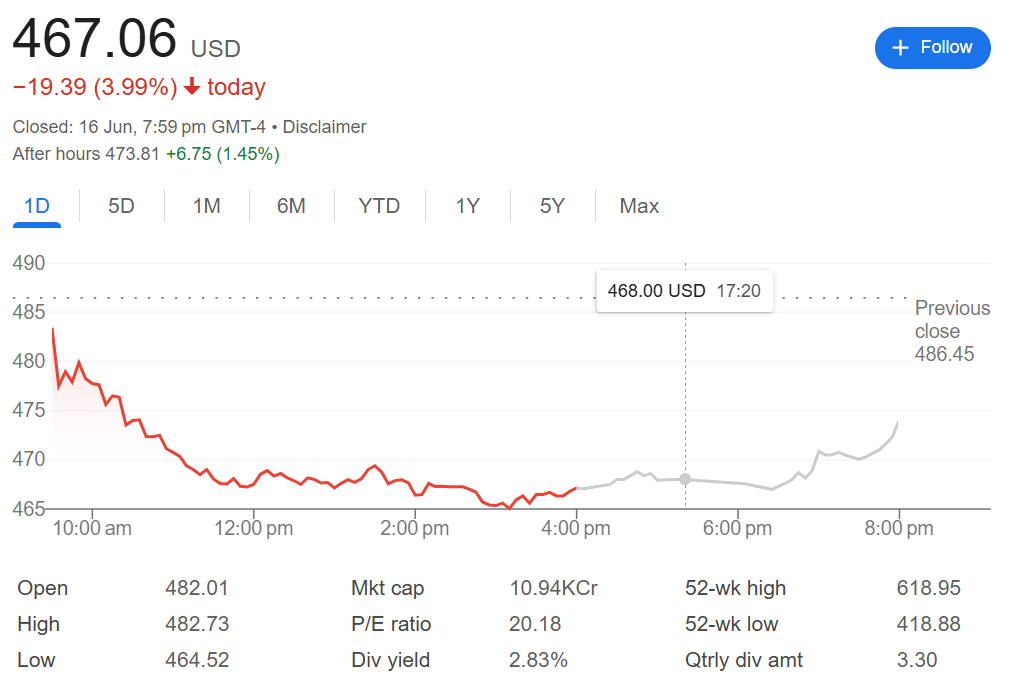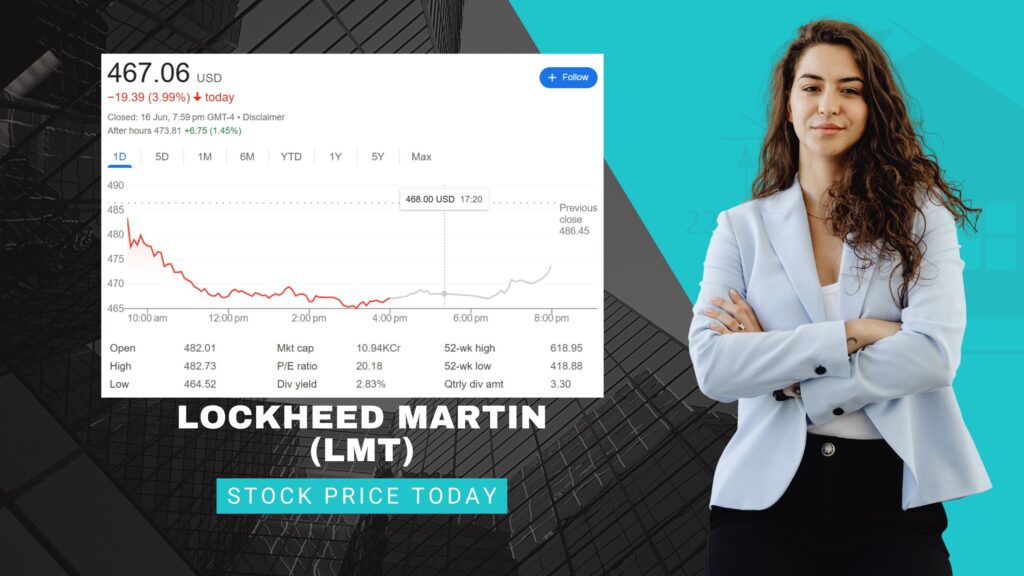Lockheed Martin (NYSE: LMT) has long been one of the most trusted defense and aerospace stocks on the market. But with the stock price hovering around $467.06 as of June 17, 2025, and the Price-to-Earnings (P/E) ratio sitting at around 20×, many investors are asking: Is Lockheed Martin a buy right now? Or is the stock fairly valued—or even overvalued?

In this in-depth article, we’ll take a closer look at Lockheed Martin’s current stock performance, its valuation metrics like the P/E ratio, industry outlook, and what it all means for investors in mid-2025.
🏷️ Lockheed Martin Stock Price Today – June 17, 2025
As of the most recent market data:
- Stock Price: $467.06 USD
- Change: –$19.30 (–3.97%)
- Day’s Range: $464.60 – $493.52
- Previous Close: $486.36
- Volume: ~2.7 million shares
This dip in share price comes after a week of volatility triggered by defense contract announcements, geopolitical shifts, and broader market pressure.
📊 Lockheed Martin’s P/E Ratio in 2025: A Closer Look
Lockheed Martin’s trailing 12-month (TTM) P/E ratio currently stands at approximately 20.1×, based on its recent earnings per share (EPS) of $23.15.
🧮 What Does That Mean?
- The P/E ratio is a way of measuring how much investors are willing to pay for each dollar of earnings.
- A P/E of 20× means investors are paying $20 for every $1 Lockheed Martin earns annually.
- It’s neither extremely cheap nor overly expensive—this puts LMT close to its historical average.
🔍 Historical Context: Is 20× a Fair Valuation?
Let’s put things into perspective:
| Timeframe | Average P/E |
|---|---|
| Last 3 Years | ~19.2× |
| Last 5 Years | ~17.9× |
| 10-Year Range | 14× – 47× |
Lockheed’s P/E spiked to 47× in 2017, largely due to tax reform and speculative growth, but it has averaged in the high teens over the last decade. At 20×, LMT is trading within a fair valuation band, especially compared to sector peers like Raytheon Technologies and General Dynamics.
📈 Why the Dip in Stock Price?
1. Boeing’s Big Win
Recently, Boeing secured a multibillion-dollar F-47 fighter jet deal, beating out Lockheed Martin. That news led to an immediate 5.8% drop in LMT stock, highlighting how sensitive defense stocks are to contract news.
2. Shifting Budgets
Although global defense spending remains high, governments are prioritizing drones, cyber defense, and AI-based warfare, which may not always benefit Lockheed’s traditional weapons platforms.

3. Market Correction & Sector Rotation
Broader market corrections, coupled with investor rotation into tech and energy stocks, have made value stocks like LMT slightly less attractive in the short term.
🛠️ Strengths That Keep LMT in the Game
Despite recent turbulence, Lockheed Martin still boasts some solid fundamentals:
🔧 Strong Order Backlog
- Over $158 billion in backlog, representing future revenue and contracts that are already secured.
💵 Healthy Free Cash Flow
- LMT generated $6.5 billion in free cash flow last year and projects similar numbers for 2025.
💰 Dividend Power
- Current dividend yield is around 2.8%, with consistent yearly increases for over 20 years.
🚀 Flagship Products
- The F-35 fighter jet program, despite facing some production delays, continues to be a core revenue driver and a long-term strategic asset.
⚠️ Risks to Consider
While LMT is a strong company, it’s not without challenges:
- Slower EPS growth: Analysts expect only 2–5% EPS growth in the next two years.
- Defense contracts are competitive: One lost bid can wipe out billions in expected revenue.
- Political uncertainty: A shift in U.S. or NATO defense policy can affect future orders.
🌎 Global Trends That Matter for Lockheed
🛡️ Rise in Defense Spending
With ongoing conflicts in Eastern Europe, the Middle East, and tensions in the Indo-Pacific, global military budgets are expanding. That creates long-term demand for aerospace systems, cyber defense, and space-based weapons—all areas Lockheed is involved in.
🤖 Shift Toward Modern Warfare
Lockheed is investing heavily in AI-powered defense, satellite communication, and hypersonic weapons, but these technologies are still maturing. Its future depends on how well it adapts and innovates in these new battlefronts.
🤔 Is Lockheed Martin Stock a Buy Right Now?
✅ Good Reasons to Buy:
- Strong fundamentals and consistent revenue.
- Safe dividend stock with long-term stability.
- Fair valuation at 20× earnings.
- Well positioned in defense, space, and cyber technology.
❌ Reasons to Wait:
- Stock could fall further if more contracts are lost.
- P/E is fair, but not a bargain.
- Limited short-term growth potential.
📝 Analyst Sentiment – What Wall Street Thinks
| Rating | % of Analysts |
|---|---|
| Buy | 44% |
| Hold | 50% |
| Sell | 6% |
Most analysts maintain a “Hold” or “Buy” rating, with a median 12-month price target of $490–$510, which would represent 5–8% upside from current levels.
📌 Final Thoughts – What Should Investors Do?
At $467 per share and a P/E ratio of around 20×, Lockheed Martin is not a screaming bargain—but it’s a solid hold or long-term buy for investors looking for dividends, reliability, and exposure to global defense growth.
If you’re an investor focused on stability, income, and moderate growth, LMT checks all the right boxes. But if you’re seeking rapid returns or high-tech innovation, you might want to keep looking.
FAQs) about Lockheed Martin Stock in 2025
❓ 1. What is Lockheed Martin’s stock price today?
As of June 17, 2025, Lockheed Martin (LMT) is trading at approximately $467.06 USD, marking a drop of about 3.97% from the previous close. The dip is largely attributed to recent defense contract news and broader market pressure.
❓ 2. What is Lockheed Martin’s P/E ratio in 2025?
Lockheed Martin’s current Price-to-Earnings (P/E) ratio is around 20.1×, which reflects a fair market valuation. It aligns closely with its 3-year average (~19×) and is considered reasonable given its stable earnings and dividend yield.
❓ 3. Is Lockheed Martin stock undervalued or overvalued right now?
LMT is fairly valued at its current P/E level. It’s not significantly undervalued, but it’s also not overpriced. Investors looking for reliable dividend income and defense sector exposure might find it appealing at current levels.
❓ 4. Why is Lockheed Martin’s stock price down recently?
The stock fell after Boeing won a major fighter jet contract that was expected to go to Lockheed. This triggered short-term selling pressure. Additionally, market rotation into tech and AI stocks has diverted attention from legacy defense firms.
❓ 5. Is Lockheed Martin a good dividend stock?
Yes. Lockheed Martin offers a stable dividend yield of around 2.8% and has a strong track record of annual dividend increases. For income investors, LMT remains a reliable long-term pick.

